Minds On
Land acknowledgement
Have you come across the following words before? Press the following titles to explore the definitions of the following words that may be unfamiliar to you.
Do you know what a land acknowledgement is? Perhaps you’ve witnessed one being read at an event or in your community.
Land acknowledgements are based on original traditions carried out by Indigenous communities in Canada. It is intended as a way to acknowledge the presence of visitors on this land and to recognize the history of colonialism and harm that has been done to Indigenous communities.
Explore the following land acknowledgements.
Record your ideas about land acknowledgements orally, digitally, in print, or in another method of your choice record what you notice, and what you wonder. If you would like, you can use speech-to-text or audio recording tools to record your thoughts. Think about:
- Why are land acknowledgments important?
- How do we think about or view the land we are on?
- What do you know about the land you live on?
- Why is the land so important?

Press the following tabs to learn about Indigenous Land acknowledgements.
Winnipeg – First Nations (modern territorial agreement/treaty) and Métis
I wish to acknowledge that we are gathered on Treaty 1 territory, traditional territory of the Anishinaabe, Cree, OjiCree, Dakota, and Dene Peoples, and on the homeland of the Métis Nation.
Source: https://www.csps-efpc.gc.ca/tools/jobaids/terr-acknowledgement-eng.aspx
Land Acknowledgement
The City of Toronto acknowledges that we are on the traditional territory of many nations including the Mississaugas of the Credit, the Anishinaabe, the Chippewa, the Haudenosaunee and the Wendat peoples and is now home to many diverse First Nations, Inuit, and Métis peoples. The City also acknowledges that Toronto is covered by Treaty 13 signed with the Mississaugas of the Credit, and the Williams Treaties signed with multiple Mississaugas and Chippewa bands.
Source: https://www.toronto.ca/city-government/accessibility-human-rights/indigenous-affairs-office/land-acknowledgement/
The Limestone District School Board is situated on the traditional territories of the Anishinaabe and Haudenosaunee. We acknowledge their enduring presence on this land as well as the presence of Métis, Inuit, and other First Nations from across Turtle Island. We honour their cultures and celebrate their commitment to this land.
Source: https://limestone.on.ca/programming/indigenous_education
Good morning / afternoon / evening.
Before we begin the _____ (name of celebration), I would like to acknowledge the traditional territory of the Tsawwassen and Musqueam First Nations and of all the Hun’qumi’num speaking people who have been stewards of this land since time immemorial.
I would also like to offer my respect to all the Elders who have gone before us and to the Elders and First Nations people who are with us today.
Source: https://www.deltasd.bc.ca/wp-content/uploads/sites/2/2018/02/Acknowlegment-of-territory-in-Delta2017.pdf
Action
Task 1: Views of the land
There are so many nations and communities that exist across Turtle Island.

Most, if not all, Indigenous communities believe that humans, fish, and animals are all equal and that the land and the water have a spirit that needs to be protected. Land in this sense cannot be owned and instead it is shared. For Indigenous peoples, land is to be respected and shared, and cannot be owned by any one individual. Indigenous communities were, and still are, concerned with taking only what they need from the land. They have their own ways of ensuring the land and the people are cared for based on their specific traditions, teachings, and geography.
Investigate the following video entitled “This Land is Our Land.” In the following video, Arthur Manuel discusses with Steve Paikin the book he co-authored with Ronald Derrickson, Unsettling Canada. Arthur Manuel was a First Nations political leader in Canada. As you are exploring the video, consider how Indigenous communities view the land and how European colonizers and their governments viewed the land historically, as well as today. You may also want to reflect on how you think about land as you learn more about diverse views around land.
When you are finished, complete the following chart by analysing the perspectives you have learned about.
How we view the land
Using what you’ve learned so far, consider each perspective of the land. Make bullet point notes about how each group (Indigenous and colonizers) viewed the land then and now. Then, consider how you view the land. What does it mean to you?
Complete the following Land Perspectives activity in your notebook, in the following fillable and printable document, or in a method of your choice. If you would like, you can use speech-to-text or audio recording tools to record your thoughts.
Press the ‘Activity’ button to access Land Perspectives.
How do you think these differing perspectives impact Indigenous and European interactions and relationships? How might it have impacted the treaty-making process?
Task 2: Fur trade competition
Prior to Europeans arriving, Indigenous people were independent from the control of foreign nations. Indigenous people had been living and trading on the territories for many years; trading was based on respect and communication. When Europeans first arrived, they were very dependent on Indigenous communities for survival. Over time, colonizers’ values shifted from survival to seeking profits from the lands and resources.
Brainstorm
Make a prediction
How do you think the change in the values of colonizers would impact Indigenous and settler relationships?
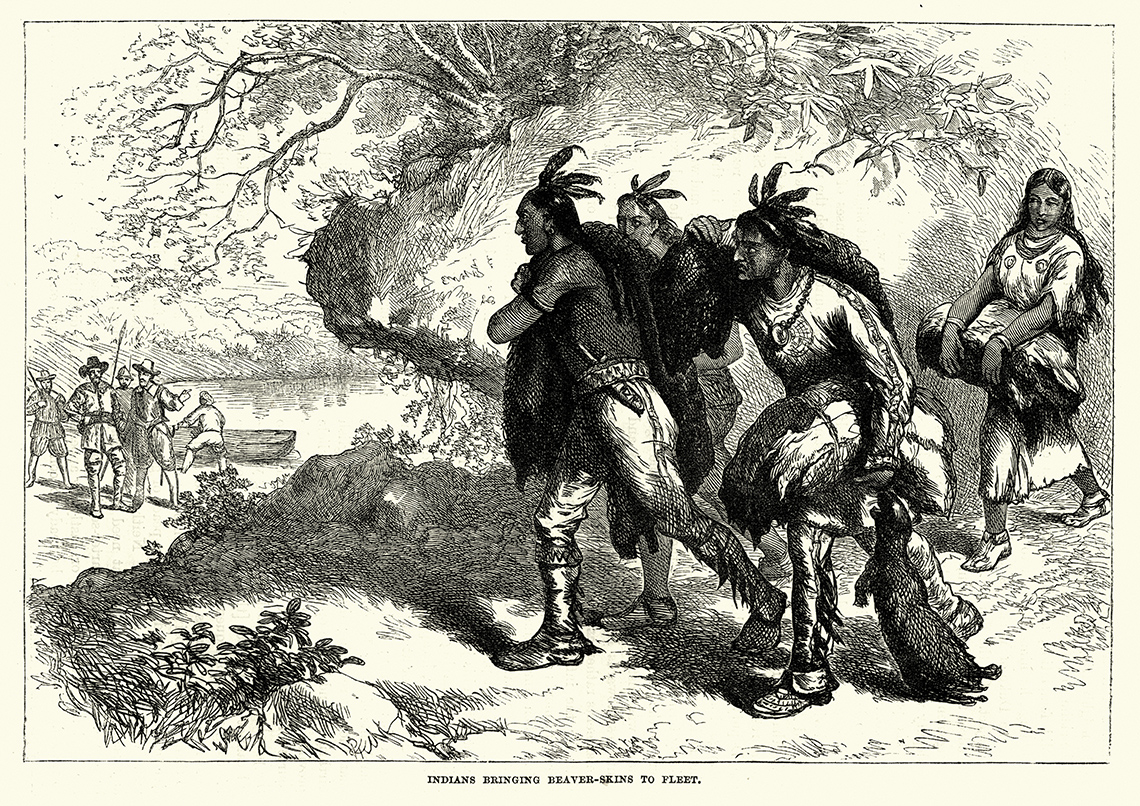
Indigenous people trading beaver skins with colonists in the 18th Century
At the beginning of the fur trade, the French mainly traded beads, pots and pans, and weapons for fur or other necessities for survival with First Nations communities. Thus, this era of the fur trade was a barter system in which pelts were exchanged for goods that the Indigenous people deemed necessary. The focus on beaver trapping (for furs) had a major impact on many Indigenous peoples. In some areas, beaver population began to decline, which increased conflicts among Indigenous communities as they competed for furs, known as the “Beaver Wars.” There was increased conflict between the Anishinaabe and Haudenosaunee. These wars resulted in the permanent displacement and destruction of several First Nations in the Eastern Woodlands, including the Huron-Wendat. Initially, Indigenous groups would take only what they needed from the land, but the fur trade economy meant they hunted more furs than needed to compete with others.
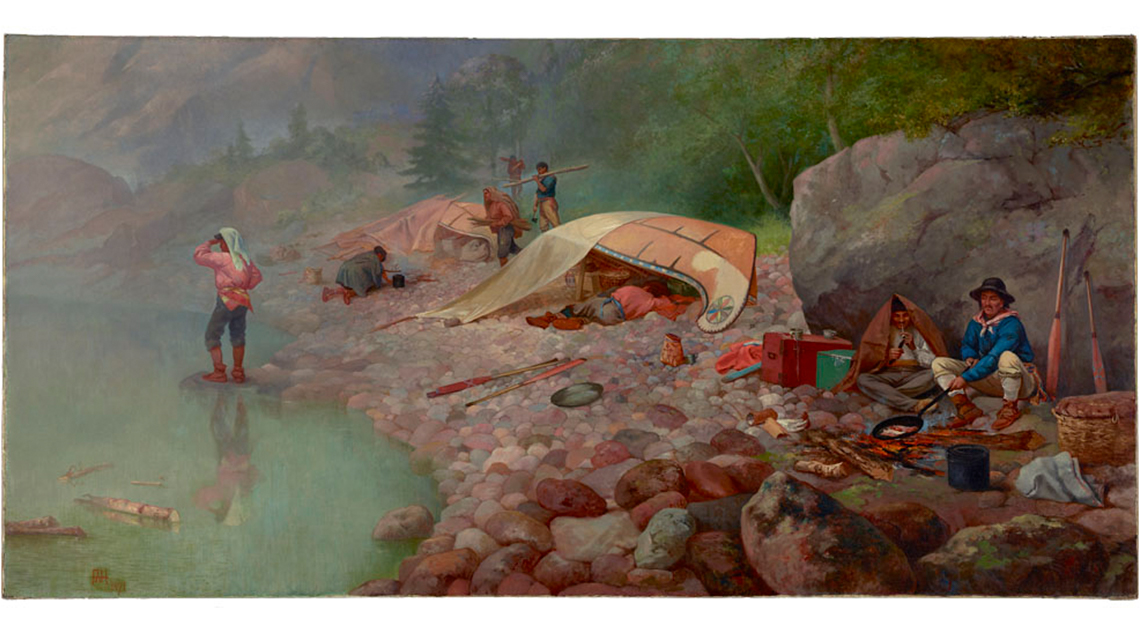
Indigenous and Métis men were often hired to paddle canoes into the interior in search of furs to trade.
However, changes in the society also reflected changes in the fur-trade relationship. No manufacturing existed in Canada yet, so all the goods needed for settlement came from Europe by ship. Ships would send goods from Britain and France for the colonizers, and leave with raw materials from Canada, such as furs, fish, and lumber. All these resources were leaving at an increasing rate and from Indigenous lands with little to no compensation.
Press Reflection to access ideas to further your learning.
What role did the pressures for natural resources (fur, fish, lumber) play in the interactions between Indigenous communities and European colonizers?
Think about how resources, such as beavers, went from plentiful to in decline.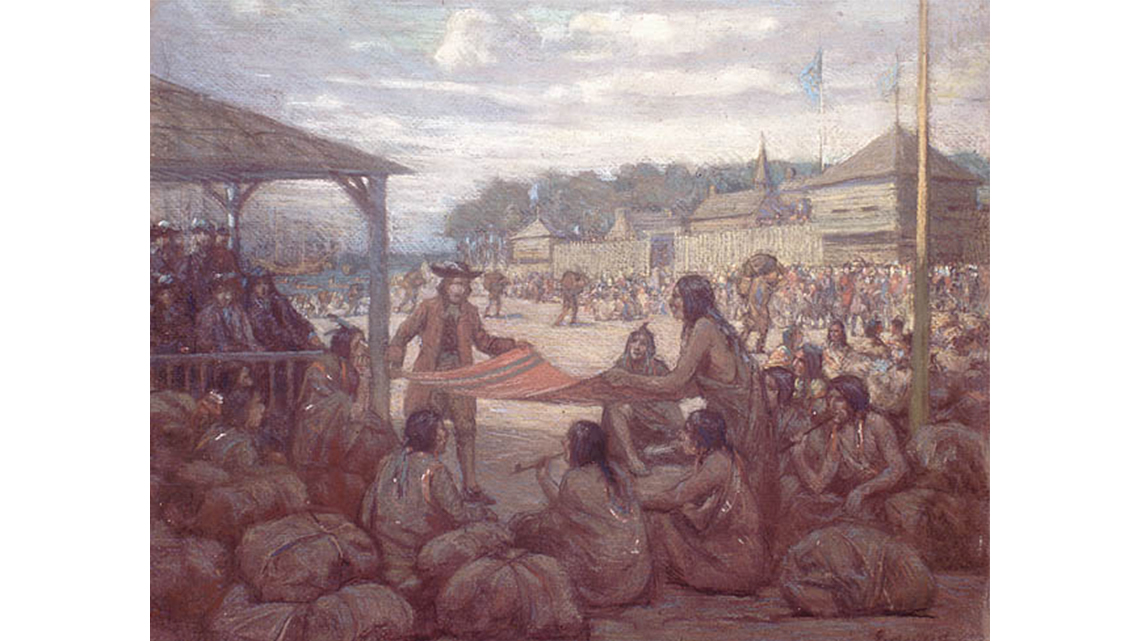
When Britain took control of New France, they also took control of, or monopoly over, the fur trade. The Hudson’s Bay Company (HBC) and North West Company (NWC) were fierce rivals in the fur trade, and both companies began to expand westward. The fur trade drove European exploration, expansion, and colonization. Nations fought each other for the wealth the fur trade brought.
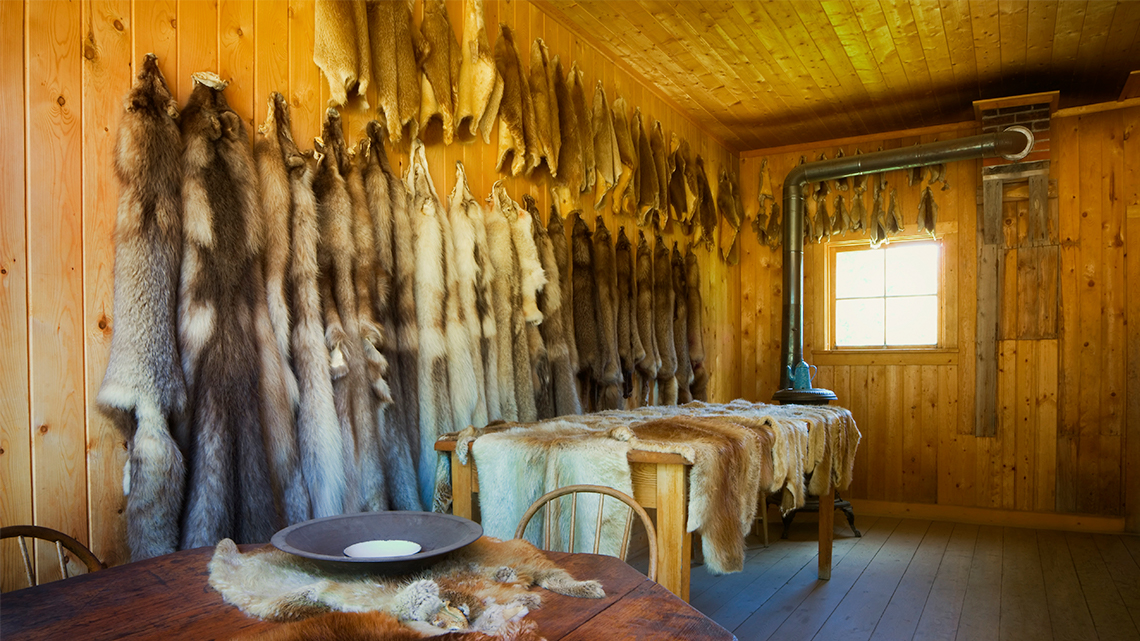
As companies expanded, the fur trade began to negatively impact Indigenous communities. Indigenous communities became dependent on European goods. While some Indigenous groups profited, others became victims of new disease and unfair trading practices that placed them at a disadvantage.
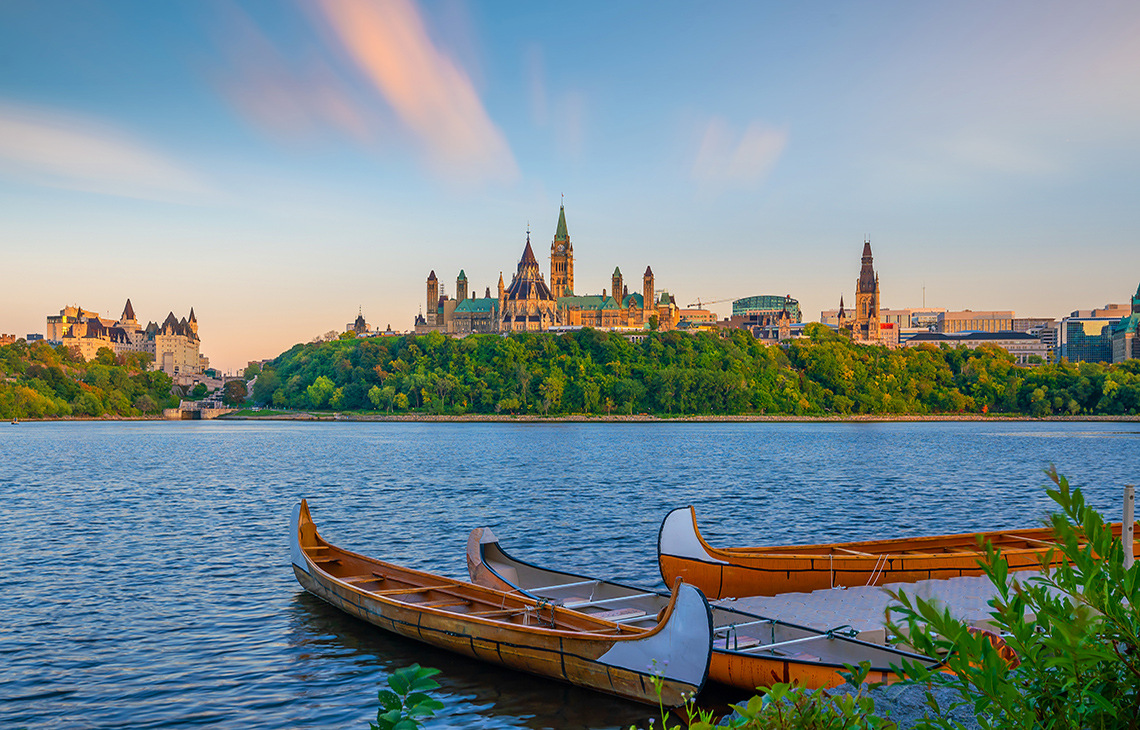
As the fur trade expanded, it served economic, political, and scientific purposes. In the 1800s, HBC transferred most of the land without input from the Métis or First Nations in the area. As the fur trade continued, colonizers began creating permanent communities near waterways where there was easy access to ships coming and going back to Europe. These settlements eventually became cities: Halifax, Montreal, Quebec, Ottawa, and Toronto. The arrival of more colonizers meant more Indigenous communities were displaced from their traditional territories with less access to food and resources. These pressures would later change the nature of the treaty-making process as treaties moved from agreements to share the land to agreements to remove Indigenous peoples from their homelands.
Source: Foster, J. E., & Eccles, W. J. (2019, November 1). Fur Trade in Canada. The Canadian Encyclopedia. https://www.thecanadianencyclopedia.ca/en/article/fur-trade.
Task 3: Mississaugas of the Credit First Nation
The Mississaugas of the Credit First Nations are part of the Ojibwe (Anishinaabe) Nation. Prior to European contact, the ancestors of the Mississaugas of the Credit First Nation occupied the lands north of Lake Superior and the area around Georgian Bay. The Mississaugas lived lightly on the lands they occupied and purposefully moved about the landscape harvesting resources as they became available. Their way of life involved mobility and shifts in resource harvesting as the season changed.
Initially, when the French colonizers arrived, they relied heavily on the expertise of the Anishinaabe, as they had lived on these lands as long as can be remembered. For example, they taught the French how to fish and harvest maple sugar and wild rice. During the fur trade era, the Mississaugas allied with French fur traders and missionaries and were regularly involved in the fur trade. A practice of giving credit that could be used to purchase goods was soon developed by French fur traders, and later English fur traders. The practice of using credit with the Mississaugas at a particular river location led to this river becoming known as the Credit River.
To the north of the great lakes is Cree and Ojibwa territory respectively. To the west of Great Lakes is Saulteaux territory. To the east of the Great Lakes is Algonquin territory near what is now referred to as Quebec and Montreal. To the east is also the Mississauga territory surrounding Lake Ontario. In the southern portion of the map is Shawnee territory as well as Miami territory, with Potawatomi territory to the northwest. To the southwest is Menominee territory. Surrounding the Great Lakes is Ojibwa territory, with Chipewas territory towards the southeast and west. The Odawa territory is near the centre between Lake Huron and Lake Michigan.
Towards the end of the 1700s, several events had long-lasting impacts on the Mississaugas of the Credit and their traditional territories. These events happened with broader social, political, and economic changes that included the development of European settlement, land grants, and land purchases. In 1784, the Mississaugas were part of a series of ‘land surrenders’ in which the British government ‘purchased’ plots of land along the Grand River. Two of the more famous purchases were called the “Toronto Purchase” and the “Gunshot Treaty.” Both of these land agreements remain controversial today, as they did not appropriately follow British legal standards at the time.
The validity of these land agreements are questionable because the Mississaugas understood these agreements very differently from the British government. The British saw the land as a commodity they were purchasing once and for all, whereas the Mississaugas did not believe their land could be ‘sold,’ or that their rights to access this land for resources could be permanently signed away. As European settlements in the Lake Ontario region grew, they started to interfere with the seasonal movements and resource harvesting of the Mississaugas, and they were forced to travel further inland and to remote hunting grounds to harvest their renewable resources. They were also forced to leave a prosperous settlement to start over again in a new location. This forced relocation caused many challenges as they were forced to give up their homelands.
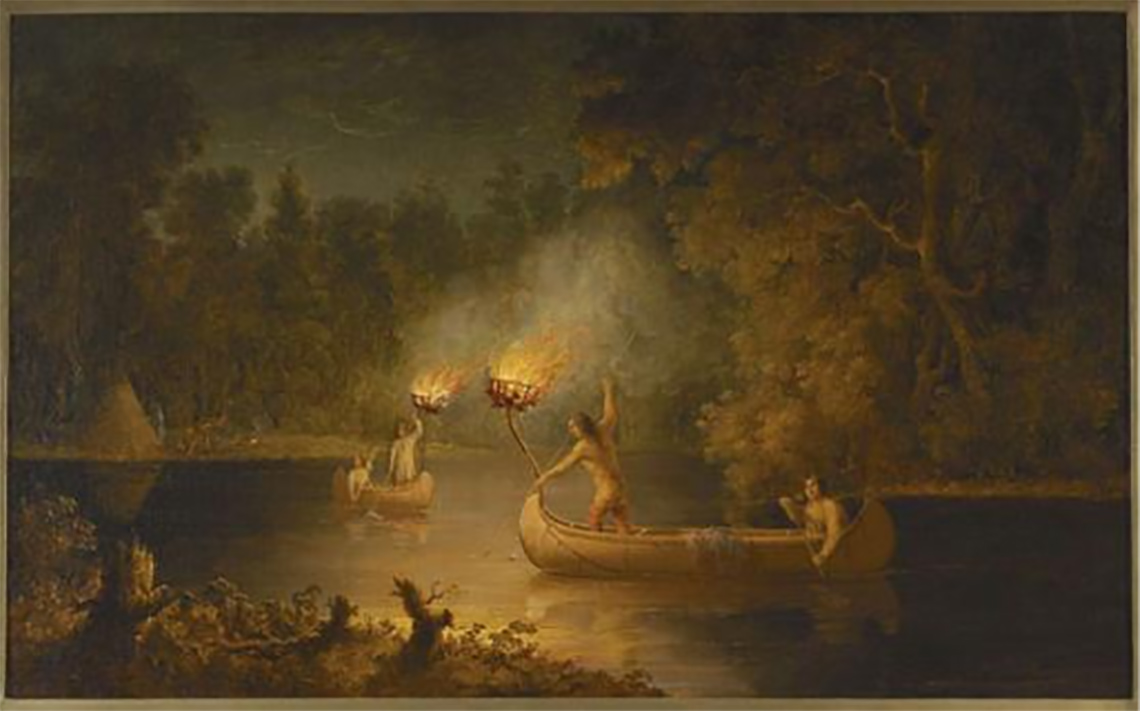
Spearfishing at night using torchlight was one kind of food harvest.
Source: Praxis Research Associates. (n.d.). The History of the Mississaugas of the New Credit First Nation. http://mncfn.ca/wp-content/uploads/2018/04/The-History-of-MNCFN-FINAL.pdf.
The Mississaugas used the same fishing techniques as their fellow Algonquians on the Upper Great Lakes.
This painting is black and white. There are trees in the background and a lake/river with two canoes in the forefront. There are men on the canoes and lights. One man is paddling and the other is holding a long spear towards the water.
Independently research the Toronto Purchase and/or the Gunshot Treaty. What and who was involved in these treaties? What lasting impact did they have on First Nations communities?
To begin your search, consider using Canadian websites such as online Canadian encyclopedias. Be sure to explore at least two separate, credible sources and consider the different perspectives on the topic.
Reflection
Why is it important to consider more than one source of information when examining a historical event?
Task 4: Modern-day connections
Traditional ways of living on the land continue to be both a vital source of subsistence and central to Indigenous peoples’ cultural identities and their protected rights under the Constitution Act. While Canada has a long-standing history of treaty-making with Indigenous peoples, there are large areas of the country where lands and resources have been taken without negotiation or consent. Even where treaties existed, the promises made within the treaties have remained largely unfilled.
Indigenous peoples in Canada have long asserted rights to a greater share of lands and resources. This includes territories that the government 'claimed' without any agreement that was negotiated with the Indigenous peoples who have lived on and utilized particular lands for generations. This also includes rights to lands and resources where formal agreements to respect these rights have been made, and then widely breached by the government.
Land rights negotiations are very much a part of modern-day Canada, but they often drag on for years or even decades without resolution.
Explore the following modern-day examples of Indigenous land claims.
Reflection
Why do you think the land claims process takes so long? Use evidence from your learning to support your answer, and record in the method of your choosing.
Consolidation
Task 1: Reflection on the fur trade

How did the fur trade competition and European settlement impact Indigenous land rights?
What short- and long-term consequences did the fur trade and settlement have on Indigenous communities and their rights to their land?
Task 2: Check your learning!
Reflect on what you’ve learned about Indigenous views of the land, fur trade competition, and the Mississaugas of the Credit First Nation. Complete the following multiple choice activity to check your learning.
Select the correct answer, then press “Check Answer” to see how you did.
Reflection
As you read the following descriptions, select the one that best describes your current understanding of the learning in this activity. Press the corresponding button once you have made your choice.
I feel...
Now, expand on your ideas by recording your thoughts using a voice recorder, speech-to-text, or writing tool.
When you review your notes on this learning activity later, reflect on whether you would select a different description based on your further review of the material in this learning activity.
Press ‘Discover More’ to extend your skills.
Discover MoreResearch activity #1: history of the land
Research the history of the lands that you are situated on and how it has evolved from the 1700s to modern day. Can you make connections to Indigenous land rights in your area?
Please record your answers in the method of your choice.
Research activity #2: treaties
Select one of the following treaties to investigate further and answer the following questions:
- Where was the treaty or law made?
- Who were the involved parties?
- Who was affected by this treaty? Were they consulted?
- How deep and long-lasting were the consequences of this treaty?
Possible research options:
- The Mi’kmaq Treaties of 1760 and 1761
- 1763 Treaty of Paris and Royal Proclamation
- The Gchi-Miigsaabiigan or Great Wampum and the Twenty-Four Nations Belt, 1764
- 1768 First Treaty of Fort Stanwix
- 1774 Quebec Act
- 1783 Treaty of Paris
- 1784 Second Treaty of Fort Stanwix
- 1791 Constitution Act for the Colony of Canada
- 1796 Jay’s Treaty